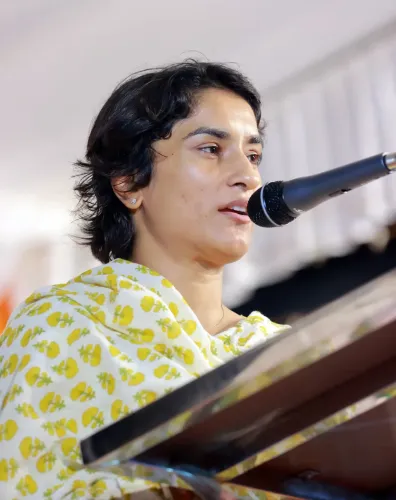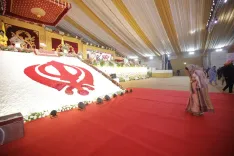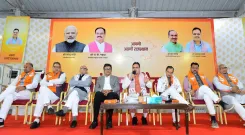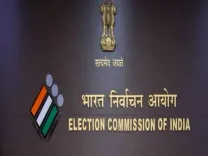Is NDA Set for a Major Victory in Bihar with 150-160 Seats?
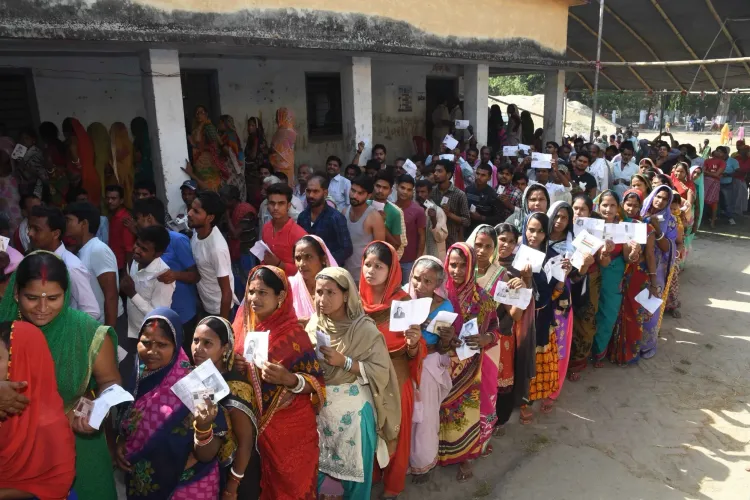
Synopsis
Key Takeaways
- NDA's strong lead with projected 49% vote share.
- Potential seats for NDA estimated at 150-160.
- BJP expected to lead the alliance with 21% votes.
- RJD remains a strong contender with 21% votes.
- Voter demographics influenced by caste and economic issues.
New Delhi, Oct 6 (NationPress) With the Election Commission of India (ECI) revealing the timeline for the Bihar Legislative Assembly elections, an opinion poll conducted by IANS-Matrize News Communications has made waves in the political arena. It forecasts an impressive advantage for the National Democratic Alliance (NDA), estimating a 49 percent vote share and 150-160 seats in the 243-member assembly.
The survey, named "Bihar Vidhan Sabha Chunav Opinion Poll-2025," highlights the ruling NDA, spearheaded by Chief Minister Nitish Kumar's JD-U and the Bharatiya Janata Party (BJP), as the leader, suggesting a potential strengthening of authority amidst continuing discussions on unemployment, migration, and governance.
According to the IANS-Matrize poll, the NDA's predicted vote share signifies a remarkable increase from the 37.3 percent it achieved in the 2020 elections, where it narrowly secured victory despite a near tie in popular votes against the opposition.
The BJP is projected to lead within the alliance, garnering 21 percent votes and 80-85 seats, illustrating its growing organizational prowess in the state.
JD-U closely follows with 18 percent votes and 60-65 seats, showcasing Nitish Kumar's enduring appeal among specific voter demographics despite his frequent changes in alliances, as indicated by the survey. Smaller allies like Hindustani Awam Morcha (HAM) at 2 percent (3-6 seats), Lok Janshakti Party (Ram Vilas) (LJP(R)) at 6 percent (4-6 seats), and Rashtriya Lok Morcha (RLM) at 2 percent (1-2 seats) contribute to the coalition's solid total.
On the opposition side, the Indi Alliance (previously known as Mahagathbandhan) is expected to secure 36 percent votes and 70-85 seats, a slight decrease from its 37.2 percent in 2020.
The Rashtriya Janata Dal (RJD), led by Tejashwi Yadav, remains the alliance's powerhouse with 21 percent votes and 60-65 seats, positioning it as a direct challenger to the NDA's supremacy, as stated by the survey.
The Indian National Congress (INC) is projected at 8 percent (7-10 seats), while left-leaning parties like the Communist Party of India (Marxist-Leninist) Liberation (CPI(ML)L) at 4 percent (6-9 seats), CPI at 1 percent (0-1 seats), and CPI(M) at 1 percent (0-1 seats) bring ideological depth to the mix.
The Vikassheel Insaan Party (VIP), which was part of the NDA in 2020, has transitioned to the INDIA Bloc, anticipated to achieve 1 percent (2-4 seats). The All India Majlis-e-Ittehadul Muslimeen (AIMIM) is expected to gather 1 percent votes and 1-3 seats, targeting minority voters in the Seemanchal regions.
A notable mention is the Jan Suraaj Party, established by political strategist Prashant Kishor, forecasted at 7 percent votes and 2-5 seats. Other parties, including the Bahujan Samaj Party (BSP) and Jharkhand Mukti Morcha (JMM), are collectively expected to receive 7 percent votes and 7-10 seats, suggesting potential kingmaker roles in a hung assembly context.
The IANS-Matrize poll's findings reveal a polarized electorate, with the NDA reaping benefits from perceived stability under Nitish Kumar, who has served as CM for multiple terms since 2005, except for brief interruptions. Nevertheless, critics highlight his alliance changes, most recently re-aligning with the NDA in January 2024, as a point of vulnerability.
In contrast, Tejashwi's performance in 2020, where the Mahagathbandhan lost by a slim margin of about 16,825 votes across crucial seats, has invigorated the opposition.
Prashant Kishor's Jan Suraaj, launched in 2022, seeks to disrupt traditional caste-based politics, leveraging his previous successes in strategizing for parties such as the BJP and JD-U.
Bihar's elections are often determined by intricate caste calculations, with communities like Yadavs (RJD's core), Kurmis (JD-U's base), and EBCs (Extremely Backward Classes) playing crucial roles. The poll indicates the NDA's broader coalition is yielding positive outcomes, but issues like joblessness—with Bihar having one of India's highest unemployment rates—and migration may influence undecided voters.
As the assembly term comes to a close on November 29, 2025, campaigns are underway, featuring high-profile rallies by national leaders such as Prime Minister Narendra Modi and Opposition Leader in the Lok Sabha Rahul Gandhi.
Experts warn that opinion polls only provide a snapshot and do not guarantee outcomes. The 2020 elections saw the NDA win 125 seats against the Mahagathbandhan's 110, even with nearly equal vote shares.
If the IANS-Matrize predictions materialize, the NDA could secure a comfortable majority, potentially re-electing Nitish or paving the way for a BJP-led government.
As Bihar prepares for what is shaping up to be a high-stakes contest, the focus remains on developmental pledges versus identity politics.
Voters, exceeding 70 million, will determine whether the state continues with the NDA's "double engine" growth model or shifts towards the opposition's welfare-driven agenda.
With the ECI's announcement, the electoral machinery is gearing up, signaling another chapter in Bihar's rich democratic saga.


